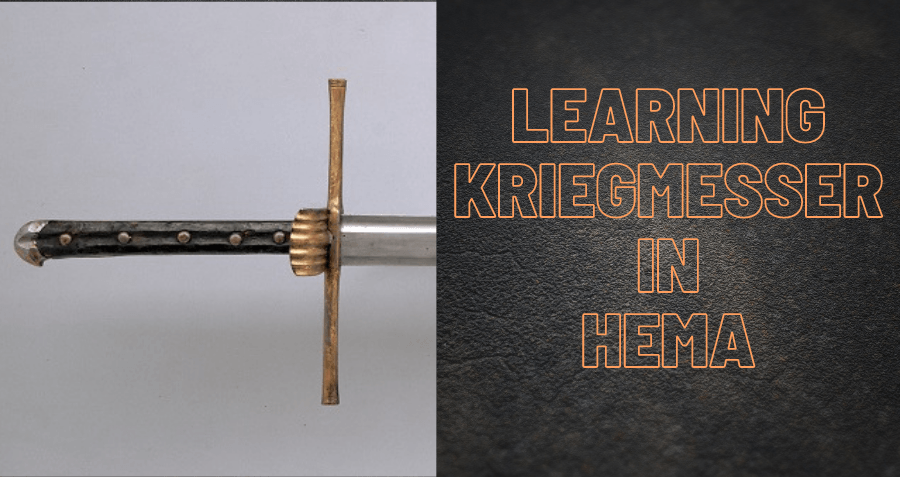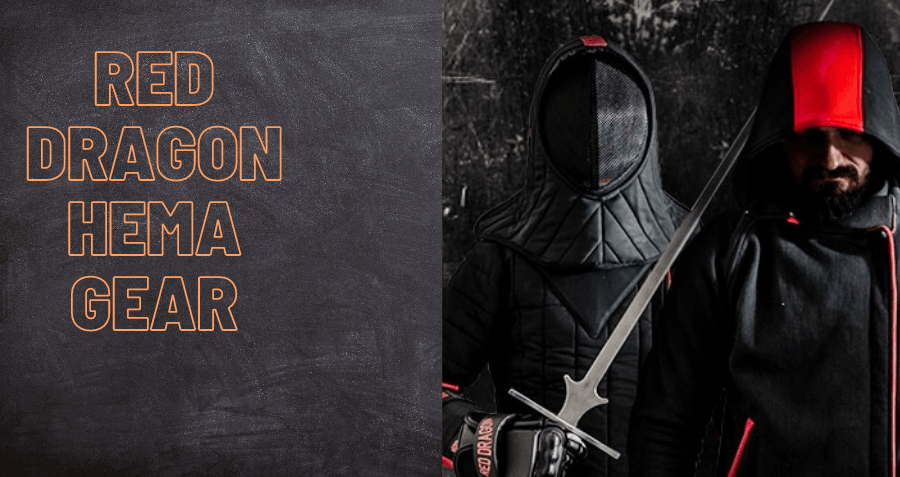This article will be very USA-centric as it is relying heavily on data extracted from Facebook analytics about the Historical European martial arts (HEMA) community. The data publicly available on Facebook comes from two primary sources; Acxiom LLC / LiveRamp Holdings Inc and Facebook’s internal analytics system that draws its conclusions by surveying the favorite pages of users and measurements created by artificial intelligence analysis of a user’s posting history in order to determine the interests of users.
That is to say the data predominantly comes from monitoring and measuring Facebook user activity. As Pew Research Center believes 7 out of 10 adults in the USA have a Facebook account this is a great source of empirical data.
As both Acxiom and Facebook’s analytics are heavily focused on the United States market (largely due to restrictive privacy laws in other countries) the information presented here is most accurate to this region, but there are some useful insights that can be gained that apply to other regions, too. If we can find similar data for other regions we may create an article abut them in the future.
Premise
The reason we are making this post is because we came across a report about this topic that we think is grossly inaccurate. A report for the International Centre of Martial Arts for Youth Development and Engagement published earlier this year (2020), claims 925 people are studying Historical European martial arts (HEMA) in the USA. We believe this is inaccurate because our club finder directory has 215 USA-based schools in it; supposing each school has at least 4 students that is 860 people in and of itself.
Yet our club finder does not yet have all clubs in the United States in it; there are many study groups we do know about who lack a website and so we cannot include them in the public database yet. We also know many clubs have far more than 4 individuals in them.
The report also makes the conclusion that there is 16,336 practitioners worldwide. Again we feel this is grossly under-representing the actual number of people who are involved in HEMA in some capacity. We believe the reason the report is so inaccurate is because only the leaders of a select number of organizations were surveyed by the report authors. As the data we present will demonstrate most people involved in HEMA in some capacity are not actually members of these organizations that were surveyed.
While we don’t want to be in the habit of publishing original research on this website we think it would be constructive for the community to see a different point of view drawn from more accurate sources of empirical data than were used in that report. Reports that under-count the number of individuals participating in HEMA in some capacity make it seem as though the efforts of those producing HEMA specific content (such as YouTube videos and websites, and publishing books) are less effective at recruiting new people into the HEMA community than they actually are.
So the purpose in writing this article is to shine a spotlight in how large the HEMA community may actually be, using Acxiom / Facebook which, while may be a very USA-centric datapool, gives a general idea of what these demographics might look like internationally.
Interests of HEMA participants
After purveying the list of interests which can be targeted using Facebook Audience Insights and conducting some test ad campaigns to see what kind of engagement is obtained on posts related to Historical fencing, we believe cross-referencing the ‘Swordsmanship’ interest category against the ‘History of Europe’, ‘Middle Ages’ and ‘Renaissance’ interest categories results in identification of individuals who can be called HEMA fencers with a high degree of certainty. This is because the performance of ads which promoted articles related to HEMA resulted in a high degree of engagement from members of the HEMA community.
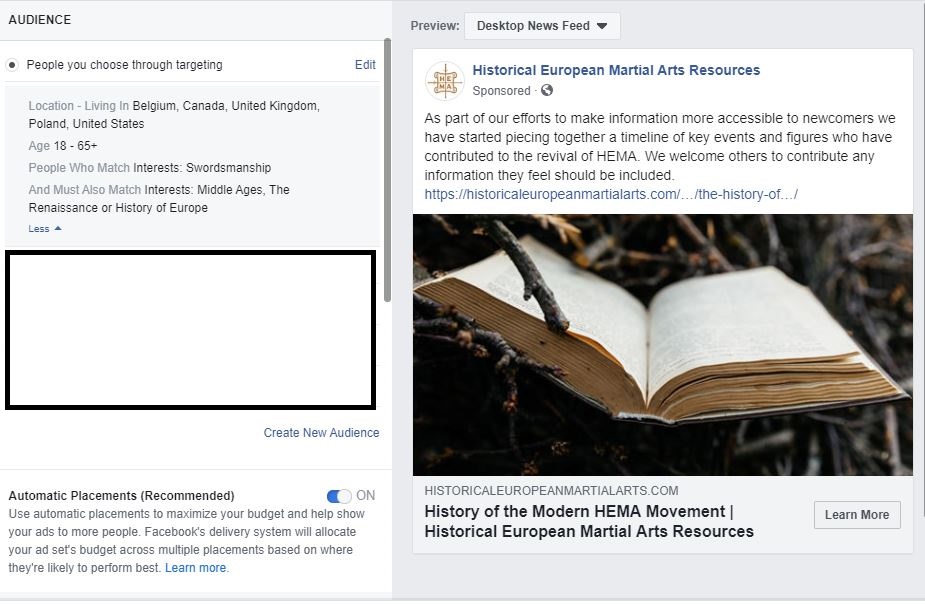
We feel it is worth pointing out the ‘swordsmanship’ category is a separate interest than ‘fencing’ and also given the ethnic breakdown of the category (which we will explore later) it is unlikely to include Asian sword based martial arts such as Kendo. The ‘swordsmanship’ category appears to be heavily Euro-centric.
Additionally the ‘swordsmanship’ interest category may have some cross-over with contemporary sport fencing interest category, but Facebook distinguishes between them.
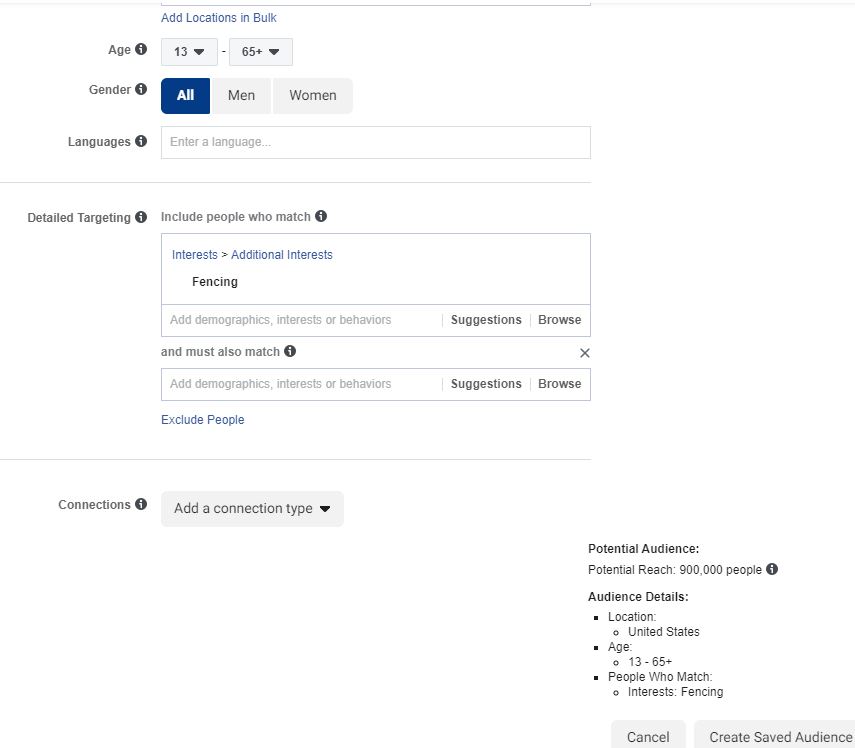
Knowing this we can now extrapolate information about the ‘HEMA’ audience group we have created by combining ‘swordsmanship’ and related history interest topics to see who it consists of and how many individuals are identifiable who belong to this targeted audience.
Unfortunately for some reason Facebook has recently removed the ‘Narrow audience’ and ‘Exclude audience’ parameters from the main Audience Insights page accessed from an administration ad account, and which would be the easiest way to show all these demographics.
However these options still exist in the Create a campaign submenus when directly creating a campaign from a Facebook Page and so that is what we will be using to present the information we have found.
American HEMA participants
The total number of people who are probably involved in HEMA in some capacity in the United States between the ages of 13 and 65+ is around 160,000 people.
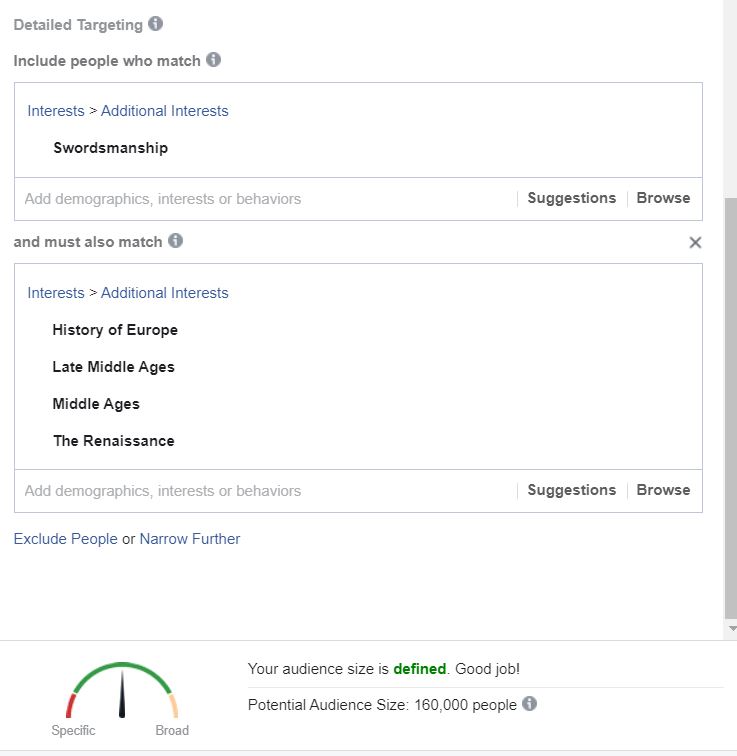
By “involved in HEMA in some capacity” we mean they at least are consumers of HEMA related media and products, and whose online activity (posting history, purchasing habits, etc) can be measured. This likely includes groups of people such as the SCA, although we cannot see exactly how many people within this audience are probably SCA members.
What we can do is exclude out people who have an interest in LARP but this only brings us down to 150,000 people.
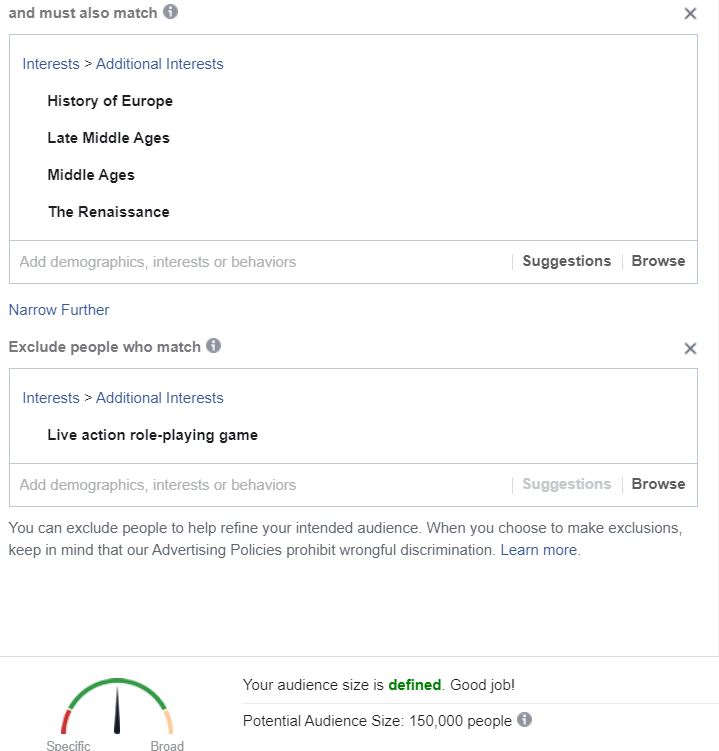
Likewise excluding people interested in ‘historical re-enactment’ also brings us to 150,000 people too.
Considering this we feel 160,000 people practicing HEMA in some capacity in the United States is a fairly accurate number even if the online Facebook groups do not necessarily have these numbers nor do the major HEMA organizations. While we cannot filter out individuals who may be more involved in Burhurt (Historical Medieval Battles) from this data it should also be considered most Burhurt athletes do in fact study HEMA materials and there is enough cross-over between these communities that efforts to exclude Burhurt participants likely results in under-reporting of the overall HEMA community.
The conclusion we have drawn here is that most HEMA practitioners are likely to be casual hobbyists who do not participate in the online discussions within the HEMA specific Facebook groups and may not be expressly a member of the larger organizational bodies, which is the same behavior we see in other interest groups for other kinds of sports and hobbies. Participation numbers for HEMA related YouTube channels suggests the numbers Facebook shows us are accurate with channels such as Schola Gladiatoria and Blood & Iron commanding significant total channel viewership and subscriber counts. We would be interested in seeing a comparison of individual HEMA-centric YouTube channels’ lifetime viewership demographic data to the data we present in this article.
At any result this view of the landscape does suggest it to be highly fragmented and individuals to be disconnected from one another, compared to active participation in the organized groups, and while we may hold our own personal beliefs about why it is so fragmented we are withholding these views from this article as they are anecdotal in nature. We leave it to others to draw their own conclusions about the data regarding this topic.
Gender
The data demonstrates that males are overwhelmingly interested in HEMA (110,000 people) although the gap with female interest (48,000) is not as large as people often assume it to be. For a combat sport these are actually very encouraging numbers for female participation.
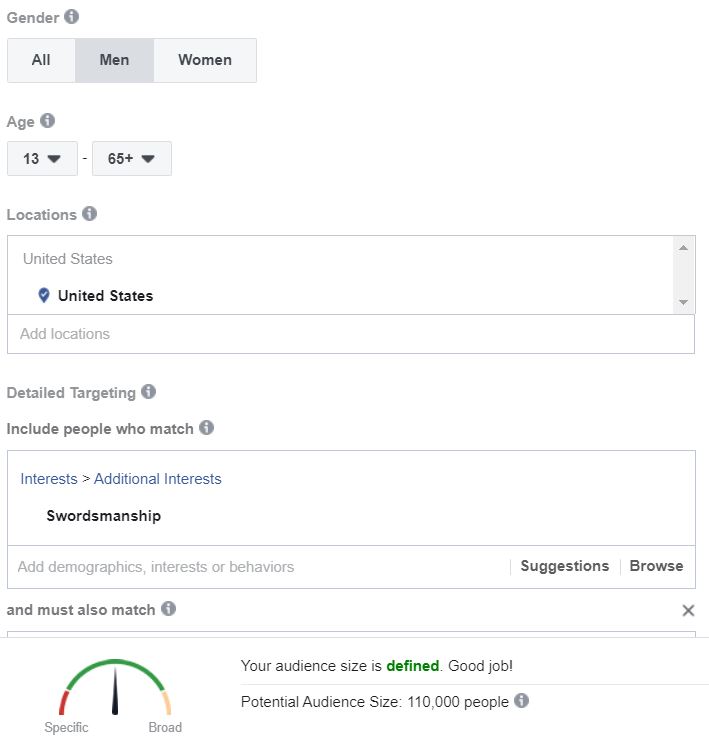
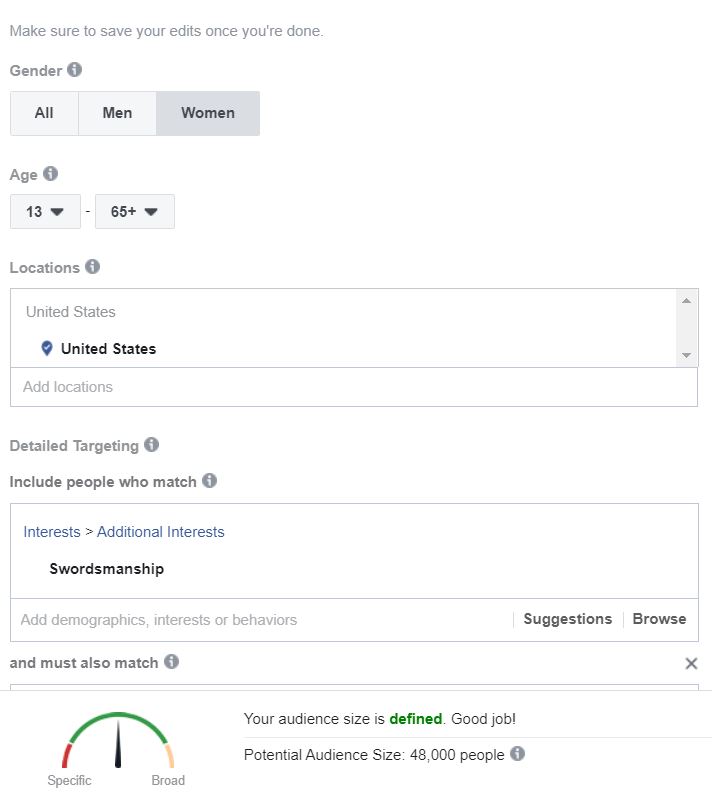
Ethnicity
Ethnic breakdown can only accurately apply within the US as this data from people elsewhere in the world is unlikely to be available given privacy laws of other regions. Also for this data we’re using the main Facebook Audience Insights tool rather than the Promoted post tool because of the difficulty in targeting by ethnicity using that tool. Unfortunately we cannot use the targeting filters for history related interests using the main Audience Insights tool, so this data comes from only the Swordsmanship interest category. This means people who are not strictly HEMA practitioners will fall into these estimates so this data isn’t as accurate as we would like, but is probably still representative of average ethnic breakdowns given the small pool of individuals who fall under this umbrella interest category.
Facebook indicates African-Americans make up the 2nd largest group interested in swordsmanship (20,000 to 25,000), with both Asians (2,000 to 2,500) and Hispanics (3,000 to 3,500) making up a smaller number. This means Caucasians are likely the majority.
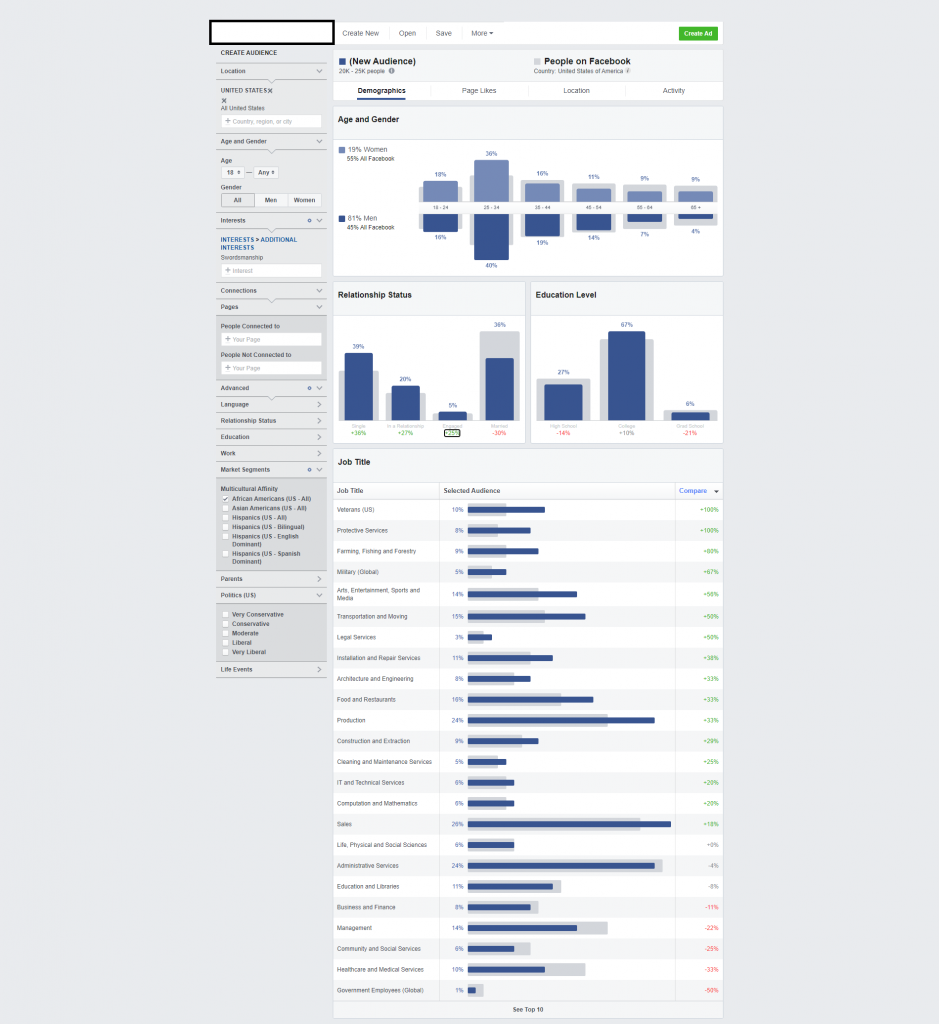
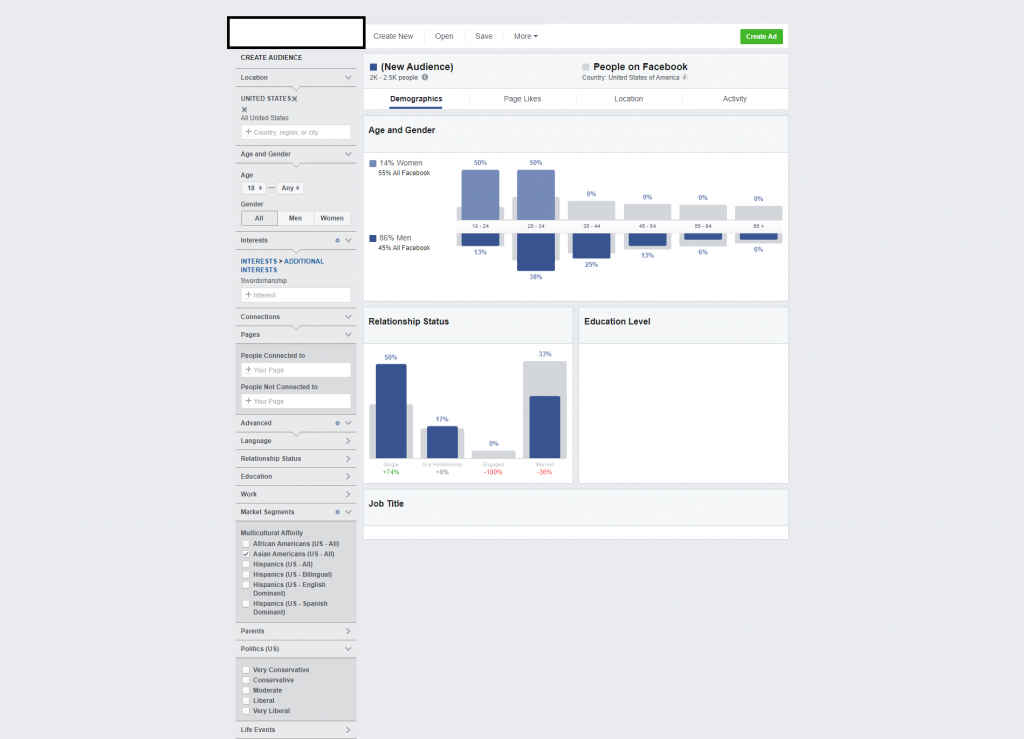
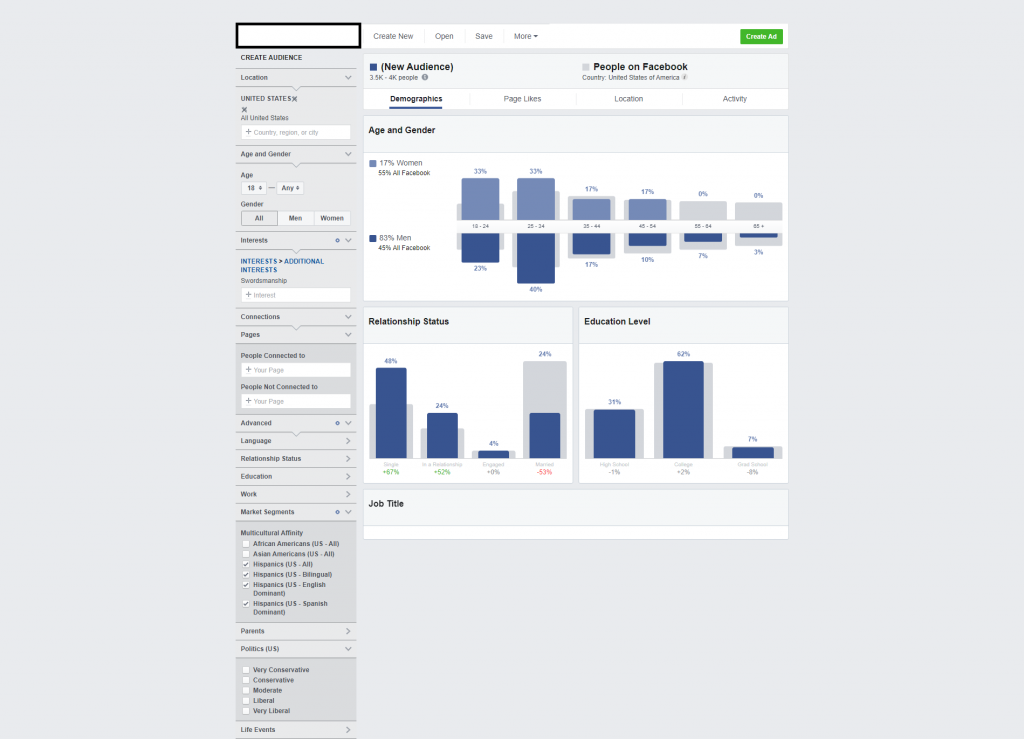
Politics and personal beliefs
As it has been demonstrated to be a subject of great interest to many within the HEMA community lately given the current political happenings taking place in the United States, we decided to take a look at what the data can tell us about the political affiliations of individuals whom Facebook has identified as being interested in ‘swordsmanship’. So we looked at political viewpoint affiliations, and political movements such as LGBT+.
We also made an effort to identify what portion of people within historical swordsmanship interest groups might potentially be “white supremacists” as this is a point of interest for some within the HEMA community.
Although Facebook does not provide a specific targeting filter for white supremacy, we can get a general idea by inference from two other interest groups that Facebook does track which are related to white supremacy; Neo-paganism and Christian Fundamentalism, the latter of which Facebook categorizes as ‘Creationism’.
Note that while Christian Fundamentalism does not expressly make one a white supremacist, Christian white supremacists will fall under the umbrella of Creationism on Facebook’s demographic filtering options. This means if there are few Creationists in the interest group then it can be inferred there are even less Christian white supremacists, too, as they are a small subset of Creationists.
The results were 2,100 people involved in some capacity with HEMA have an interest in Creationism.
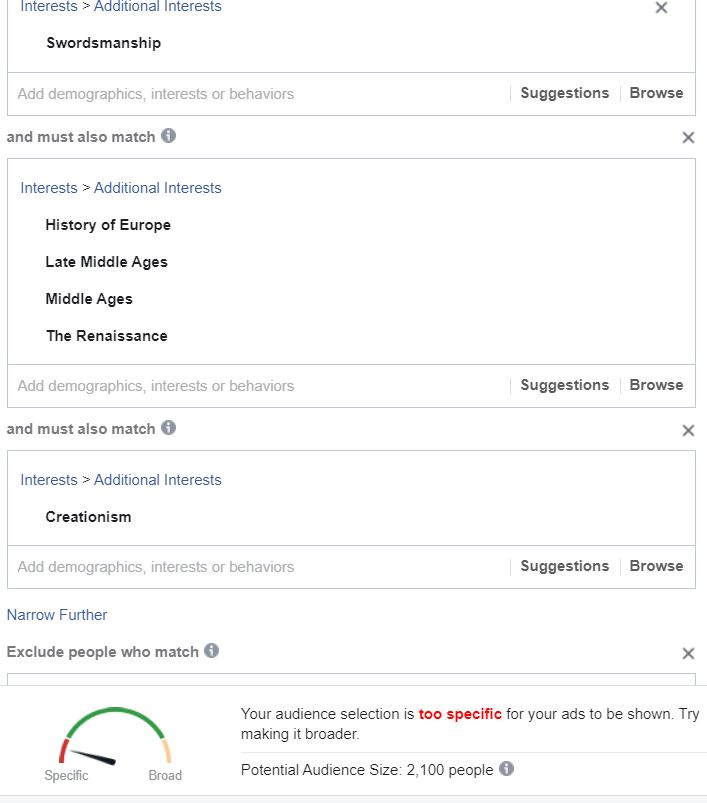
Interestingly Facebook does track Odinism, a subsect of neo-paganism specific to Norse mythology and from which white supremacist groups that are not Christian based predominantly can be classified as falling under. Note that much like Creationism that Odinism does not expressly make one a white supremacist but rather that if there are any non-Christian white supremacists then they will almost certainly fall under the Odinism umbrella. This means if there is very few Odinisists interested in swordsmanship then there is likely even less white supremacists Odinists.
The data implies this is the case; it can identify only roughly 1,600 people that fall into this category.
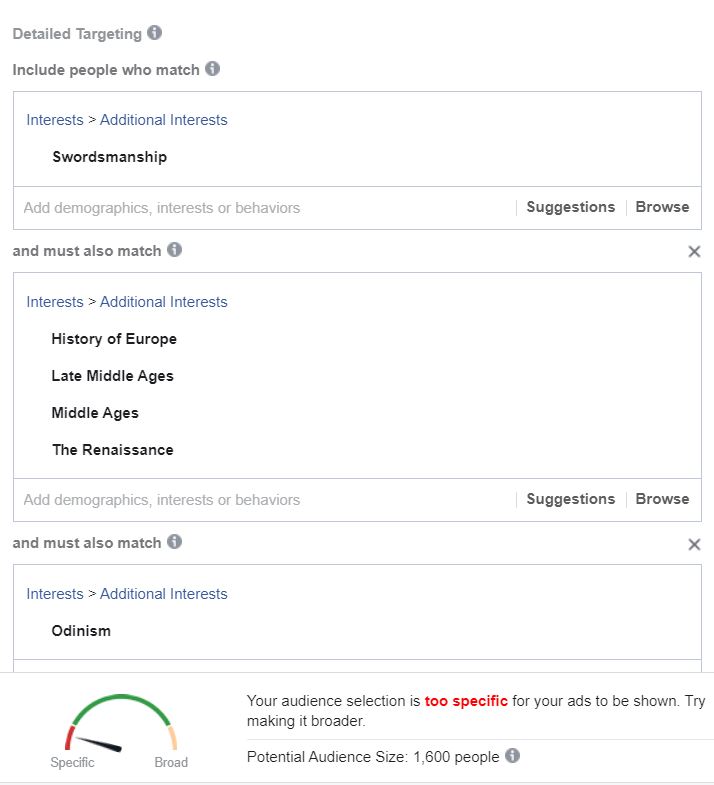
As for the larger neo-paganism community this is labeled as ‘Modern paganism’ by Facebook and while it can identify a higher number of pagans (5,500 people) compared to Odinists, it must be remembered that neo-paganism is overwhelmingly represented by Wiccans, a group which is not normally associated with white supremacy.
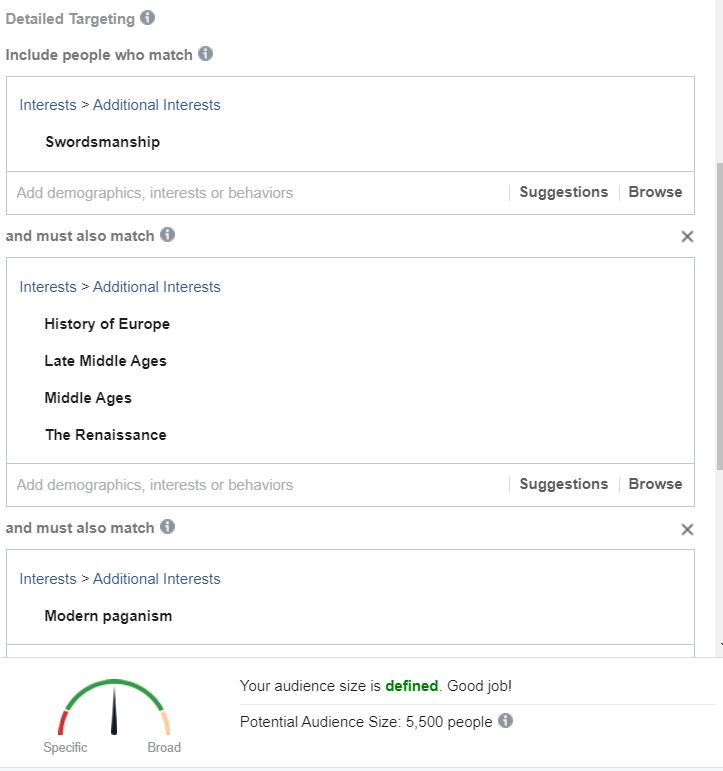
This data combined together indicates the group of potential white supremacists in the HEMA community is so small as to be statistically insignificant when compared to the majority. So the perception that white supremacists are a major force within HEMA in the USA is not identifiable in the data.
The conclusion here is Facebook’s data indicates there probably are not many individuals within the general swordsmanship interest category that can be properly labeled white supremacists living in the USA. We hope this data can relieve some people’s concerns about this topic although we understand there are those who prefer beliefs based on their anecdotal experiences, and no amount of empirical data will persuade them from the beliefs they hold to.
By comparison there is a significant number of individuals who are supportive of LGBT+ causes (89,000 people) that can be identified. That is to say of the 160,000 people Facebook can identify as being involved in the HEMA community in some capacity, 55.625% can be identified by Facebook as supportive of LGBT+ causes.
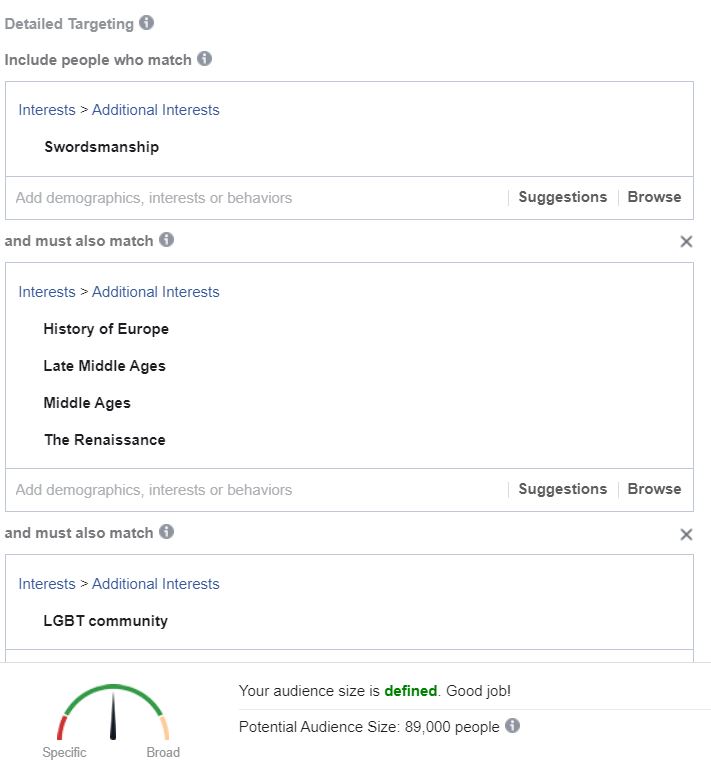
Note that Facebook only tracks individuals who expressly support such causes and it does not have a filtering option specifically for those who are anti-LGBT+. It would be incorrect to say those not expressly engaged in activity promoting LGBT+ causes are against them. Rather they just do not exhibit activity in promoting these causes which Facebook can track.
We also can see how many individuals can be identified as supportive of the Black Lives Matter movement (29,000). As with LGBT+ the same applies here; this does not necessarily mean these are the only individuals supportive of BLM but rather this is whom Facebook can identify as being supportive.
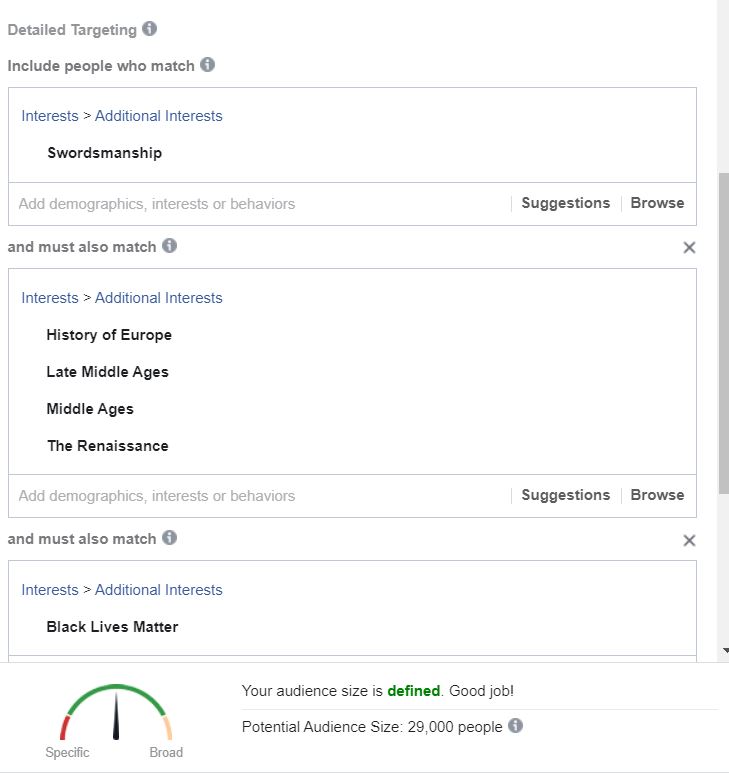
It is also worth pointing out BLM is a very specific political movement which is a sub-group within the civil rights movement. There is actually a separate filtering option for civil and political rights and Facebook identifies 27,000 individuals within the HEMA community as being interested in this.
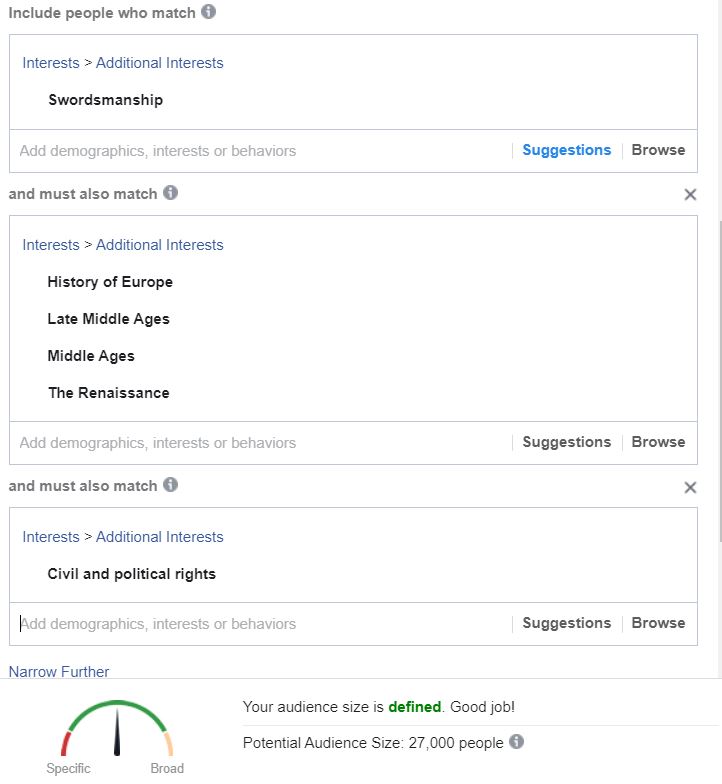
To finish this section out we can also identify 58,000 people who care about women’s rights.
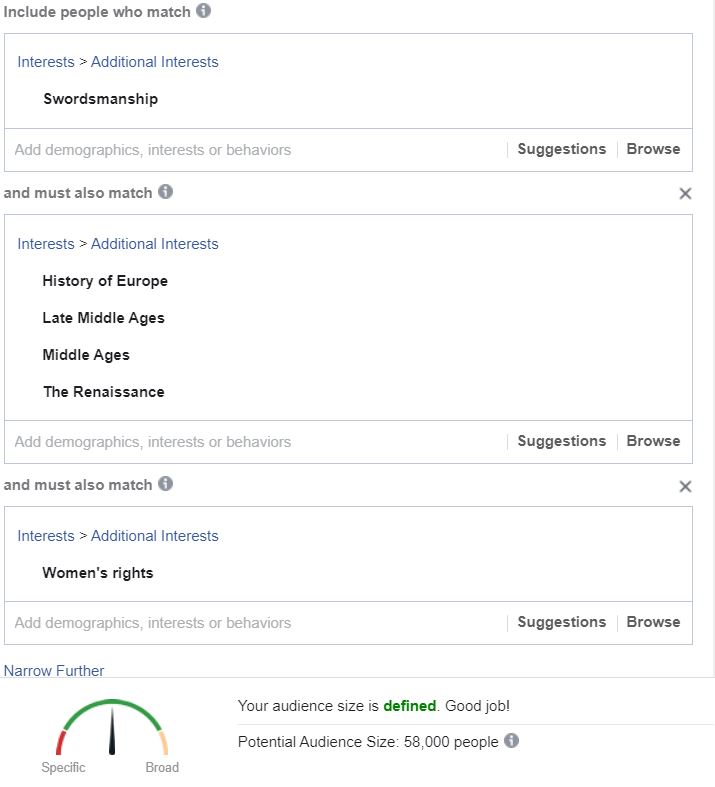
While we can draw no specific conclusions about how much these political movements matter to the overall HEMA community the data does seem to suggest they matter greatly to a part of the community.
As far as more general politics are concerned, as with ethnicities this data had to be pulled from the Audience Insights tool, as the promoted post tool did not have the necessary filtering options.
The data this tool shows demonstrates there are similar numbers of Very Conservative (2,000 to 2,500) and Very Liberal individuals (2,500 to 3,000), and a larger number of Liberal (8,000 to 9,000) compared to Conservative members (3,500 to 4,000).
Moderates make up 6,000 to 7,000 individuals that can be identified.
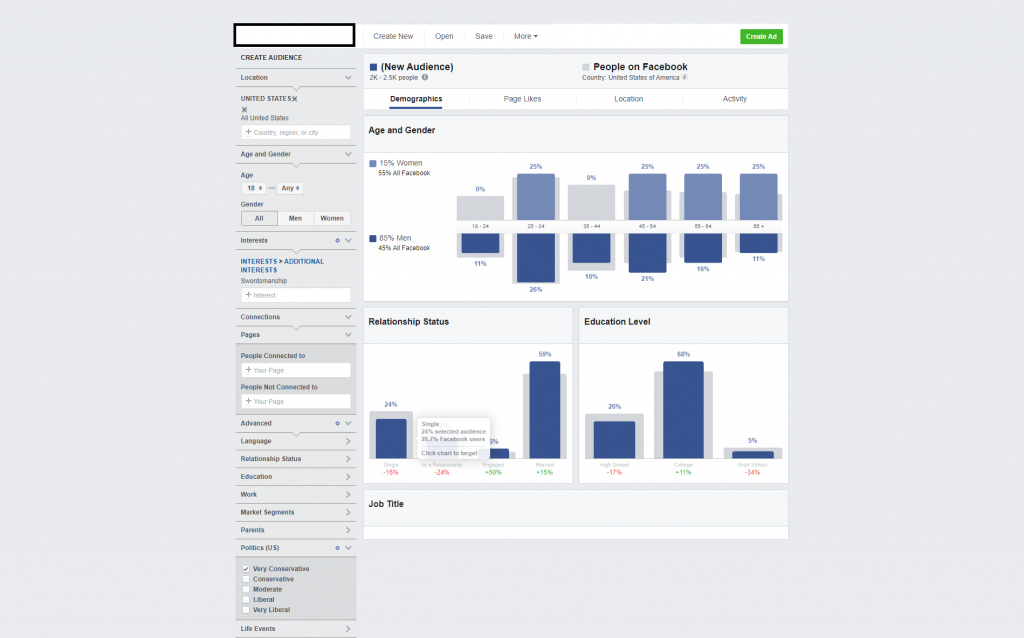
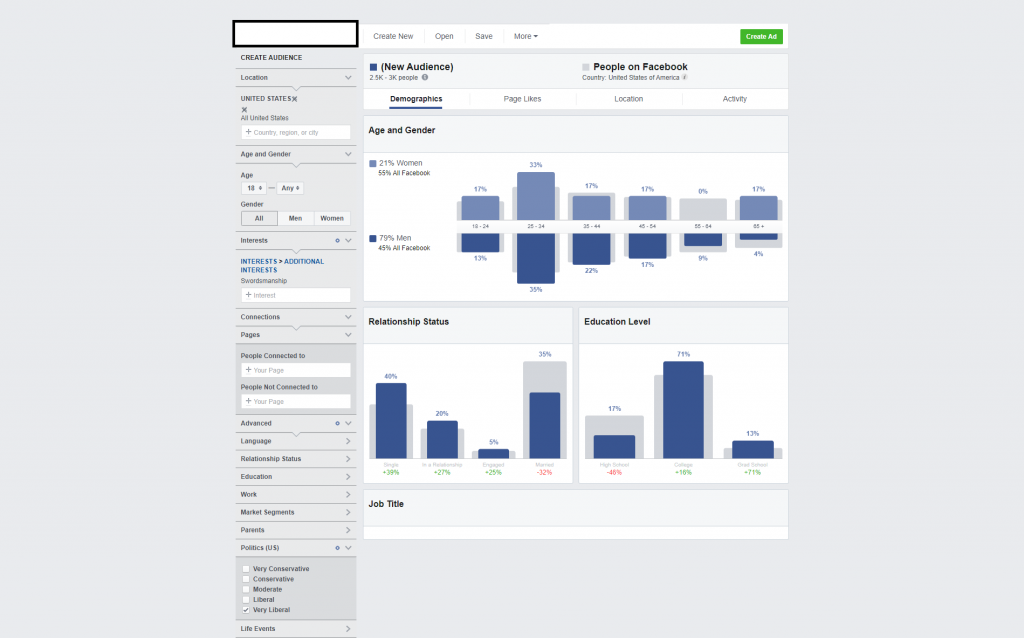
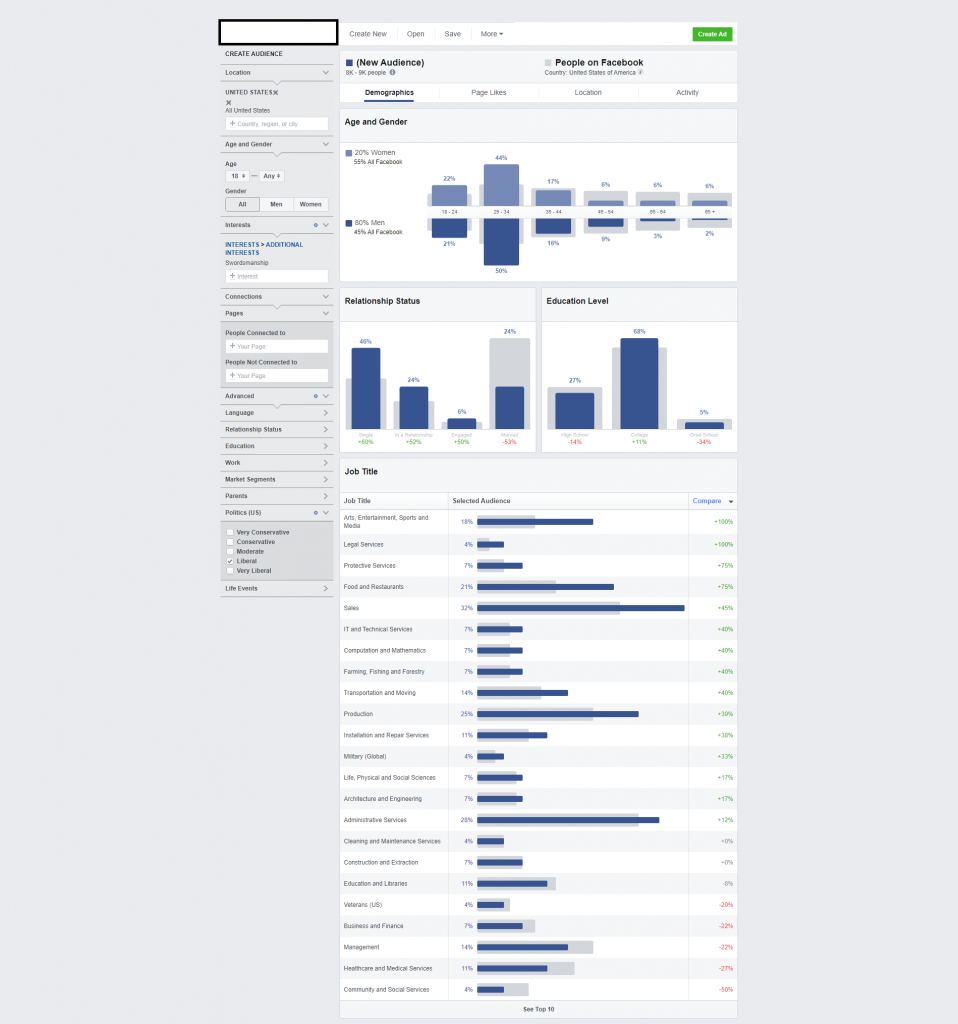
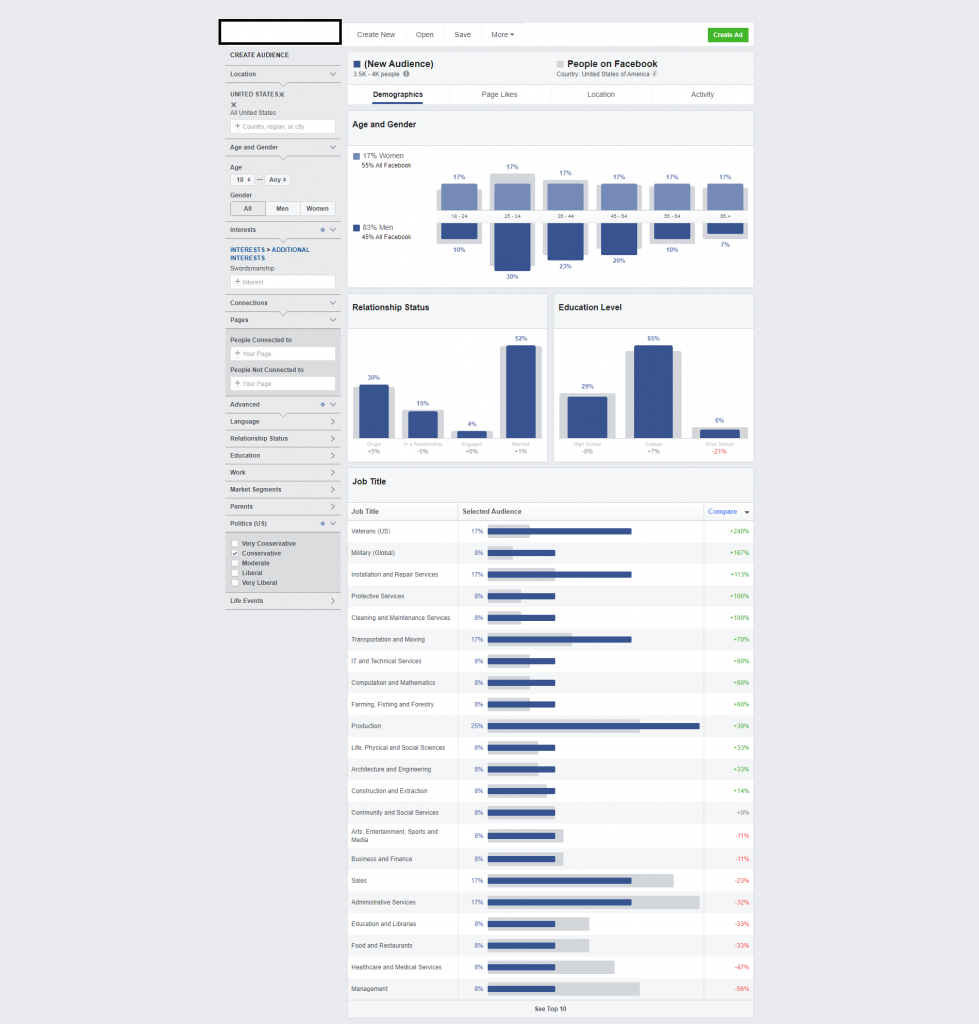
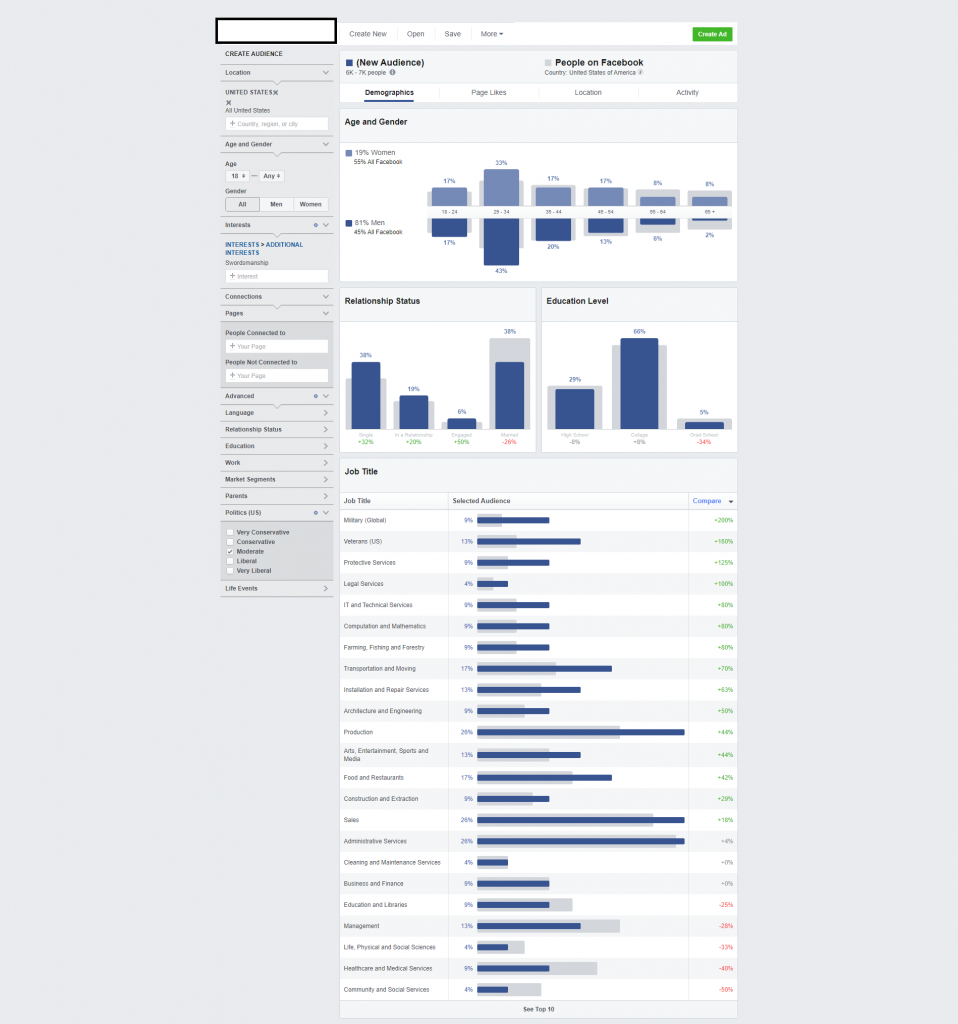
Although Facebook doesn’t have political affiliation data on the entire pool of individuals interested in swordsmanship within the USA, the data they do have suggests the political viewpoints of the HEMA community in the United States is fairly balanced across the political spectrum, with extreme liberals and extreme conservatives making up the smallest groups in terms of total numbers.
Why This Data is Reliable
Now there will surely be those who see this information and protest the conclusions, as they do not correlate to their anecdotal experiences. Yet the problem with anecdotal experiences is that they are subject to personal bias held by the individual; this is why anecdotal accounts are not scientific. Empirical data can be, but simply collecting a few anecdotal accounts does not transform them into empirical data. Yet while that very thing is often commonly done, it is not a scientific method of breaking down populations by their interests and activities.
Having said that, simply sharing results from Facebook’s analytics is not strictly scientific either. We didn’t create the dataset after all so we don’t know the specific decisions used to categorize individuals. We’re just leveraging their database to provide another viewpoint to contrast to the report we disagree with, as its conclusions contradict what we know for sure about the US landscape based on our club finder records.
What is useful about Facebook is that it does not collect data by surveying users. Surveys are one of the least reliable data pools because people tend to lie on surveys. So instead Facebook monitors and measures the actual activity of users using algorithms designed to be free of personal bias. Facebook does this because it is motivated to create a very good advertising system, and the quality of their data on users is their only product. If the data is incorrect Facebook will lose its paying customers — the ad agencies — because they will waste money on ad campaigns that do not generate customers for their business clients. We can therefore trust in the data, especially as testing of the ad campaigns we’ve done has indeed produced a lot of engagement from those within the HEMA community.
Consequently Facebook has very reliable data about its users and we can see some of this data when using its ad system to generate audiences for ad campaigns and extrapolate this data to form ideas about the demographic subgroups it can identify.
Now the data Facebook provides does contradict some perceptions people have, so it’s useful to keep in mind Facebook can only measure by things like consumption of media, posting history and purchasing habits. So it does not differentiate between tiers of participation in a community, such as people who do their activities in a non-HEMAA club environment, such as informal study groups, SCA, Burhurt, etc. or people who have gone to a club and done classes, but left for whatever reason, yet maintain an interest in HEMA, or even people who are aware of HEMA but have never gone to a club, and currently are only consumers of media related to it and may own some products as well. It seems to be commonly believed by some within the HEMA community that only people who are inside a recognizable HEMA club are “part of the community”, but people in that category are actually 4 or 5 levels down into the funnel of participation. A community is always a reverse pyramid, with the majority at the top and fewer at the bottom.
While we have no control over how others will use the data we have presented we hope it can be used to make more data-driven decisions by schools, vendors and other organizations to further the growth of HEMA.
****
If you’d like to learn more information about historical fencing practices please check out our Learn HEMA page for a guide to learning about the historical weapon that interests you. You can also find more guides we’ve written about other topics at our Helpful Guides page.
Related posts:
- How to Clean and Care for Your swords and Federschwert in HEMA (Plus Storage and Transport Advice)
- Modern Olympic Fencing Vs HEMA: What Are the Differences?
- Our Favorite Historical European Martial Arts reddit post threads
- Important Safety Tips for Historical European Martial Arts Fencing with Swords

